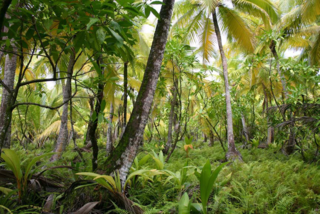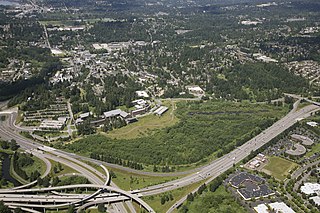Ecological selection refers to natural selection without sexual selection, i.e. strictly ecological processes that operate on a species' inherited traits without reference to mating or secondary sex characteristics. The variant names describe varying circumstances where sexual selection is wholly suppressed as a mating factor.

Pioneer species are hardy species that are the first to colonize barren environments or previously biodiverse steady-state ecosystems that have been disrupted, such as by wildfire.

In scientific ecology, climax community or climatic climax community is a historic term for a community of plants, animals, and fungi which, through the process of ecological succession in the development of vegetation in an area over time, have reached a steady state. This equilibrium was thought to occur because the climax community is composed of species best adapted to average conditions in that area. The term is sometimes also applied in soil development. Nevertheless, it has been found that a "steady state" is more apparent than real, particularly across long timescales. Notwithstanding, it remains a useful concept.

Ecological succession is the process of change in the species structure of an ecological community over time. The time scale can be decades or more or less.

Primary succession is the beginning step of ecological succession after an extreme disturbance, which usually occurs in an environment devoid of vegetation and other organisms. These environments are typically lacking in soil, as disturbances like lava flow or retreating glaciers shred the environment of nutrients.

Forest dynamics describes the underlying physical and biological forces that shape and change a forest ecosystem. The continuous state of change in forests can be summarized with two basic elements: disturbance and succession.

The intermediate disturbance hypothesis (IDH) suggests that local species diversity is maximized when ecological disturbance is neither too rare nor too frequent. At low levels of disturbance, more competitive organisms will push subordinate species to extinction and dominate the ecosystem. At high levels of disturbance, due to frequent forest fires or human impacts like deforestation, all species are at risk of going extinct. According to IDH theory, at intermediate levels of disturbance, diversity is thus maximized because species that thrive at both early and late successional stages can coexist. IDH is a nonequilibrium model used to describe the relationship between disturbance and species diversity. IDH is based on the following premises: First, ecological disturbances have major effects on species richness within the area of disturbance. Second, interspecific competition results in one species driving a competitor to extinction and becoming dominant in the ecosystem. Third, moderate ecological scale disturbances prevent interspecific competition.
Xerosere is a plant succession that is limited by water availability. It includes the different stages in a xerarch succession. Xerarch succession of ecological communities originated in extremely dry situation such as sand deserts, sand dunes, salt deserts, rock deserts etc. A xerosere may include lithoseres and psammoseres.

A hydrosere is a plant succession which occurs in an area of fresh water such as in oxbow lakes and kettle lakes. In time, an area of open freshwater will naturally dry out, ultimately becoming woodland. During this change, a range of different landtypes such as swamp and marsh will succeed each other.

Secondary succession is the secondary ecological succession of a plant's life. As opposed to the first, primary succession, secondary succession is a process started by an event that reduces an already established ecosystem to a smaller population of species, and as such secondary succession occurs on preexisting soil whereas primary succession usually occurs in a place lacking soil. Many factors can affect secondary succession, such as trophic interaction, initial composition, and competition-colonization trade-offs. The factors that control the increase in abundance of a species during succession may be determined mainly by seed production and dispersal, micro climate; landscape structure ; bulk density, pH, and soil texture.

In ecology, a disturbance is a temporary change in environmental conditions that causes a pronounced change in an ecosystem. Disturbances often act quickly and with great effect, to alter the physical structure or arrangement of biotic and abiotic elements. A disturbance can also occur over a long period of time and can impact the biodiversity within an ecosystem.
"Auto-" meaning self or same, and "-genic" meaning producing or causing. Autogenic succession refers to ecological succession driven by biotic factors within an ecosystem and although the mechanisms of autogenic succession have long been debated, the role of living things in shaping the progression of succession was realized early on. Presently, there is more of a consensus that the mechanisms of facilitation, tolerance, and inhibition all contribute to autogenic succession. The concept of succession is most often associated with communities of vegetation and forests, though it is applicable to a broader range of ecosystems. In contrast, allogenic succession is driven by the abiotic components of the ecosystem.

Plant ecology is a subdiscipline of ecology that studies the distribution and abundance of plants, the effects of environmental factors upon the abundance of plants, and the interactions among plants and between plants and other organisms. Examples of these are the distribution of temperate deciduous forests in North America, the effects of drought or flooding upon plant survival, and competition among desert plants for water, or effects of herds of grazing animals upon the composition of grasslands.

Climax species, also called late seral, late-successional, K-selected or equilibrium species, are plant species that can germinate and grow with limited resources; e.g., they need heat exposure or low water availability. They are the species within forest succession that are more adapted to stable and predictable environments, and will remain essentially unchanged in terms of species composition for as long as a site remains undisturbed.

Riparian-zone restoration is the ecological restoration of riparian-zonehabitats of streams, rivers, springs, lakes, floodplains, and other hydrologic ecologies. A riparian zone or riparian area is the interface between land and a river or stream. Riparian is also the proper nomenclature for one of the fifteen terrestrial biomes of the earth; the habitats of plant and animal communities along the margins and river banks are called riparian vegetation, characterized by Aquatic plants and animals that favor them. Riparian zones are significant in ecology, environmental management, and civil engineering because of their role in soil conservation, their habitat biodiversity, and the influence they have on fauna and aquatic ecosystems, including grassland, woodland, wetland or sub-surface features such as water tables. In some regions the terms riparian woodland, riparian forest, riparian buffer zone, or riparian strip are used to characterize a riparian zone.
The Janzen–Connell hypothesis is a widely accepted explanation for the maintenance of tree species biodiversity in tropical rainforests. It was published independently in the early 1970s by Daniel Janzen and Joseph Connell. According to their hypothesis, host-specific herbivores, pathogens, or other natural enemies make the areas near a parent tree inhospitable for the survival of seedlings. These natural enemies are referred to as 'distance-responsive predators' if they kill seeds or seedlings near the parent tree, or 'density-dependent predators' if they kill seeds or seedlings where they are most abundant. Such predators can prevent any one species from dominating the landscape, because if that species is too common, there will be few safe places for its seedlings to survive. However, because the predators are host-specific, they will not harm other tree species. As a result, if a species becomes very rare, then more predator-free areas will become available, giving that species' seedlings a competitive advantage. This negative feedback allows the tree species to coexist, and can be classified as a stabilizing mechanism.
Joseph Hurd Connell FAA was an American ecologist. He earned his MA degree in zoology at the University of California, Berkeley and his PhD at Glasgow University. Connell's first research paper examined the effects of interspecific competition and predation on populations of a barnacle species on the rocky shores of Scotland.</ref> According to Connell, this classic paper is often cited because it addressed ecological topics that previously had been given minor roles. Together, with a subsequent barnacle study on the influence of competition and desiccation, these two influential papers have laid the foundation for future research and the findings continue to have relevance to current ecology. His early work earned him a Guggenheim fellowship in 1962 and the George Mercer Award in 1963.

Arctostaphylos rubra is a species of flowering plant in the heath family and the genus Arctostaphylos, the manzanitas and bearberries. Common names include red fruit bearberry, alpine bearberry, arctic bearberry, red manzanita, and ravenberry. It is native to Eurasia and northern North America from Alaska through most of Canada to Greenland. There is also one population in the contiguous United States, located in the Absaroka Mountains of Wyoming.

Gap dynamics refers to the pattern of plant growth that occurs following the creation of a forest gap, a local area of natural disturbance that results in an opening in the canopy of a forest. Gap dynamics are a typical characteristic of both temperate and tropical forests and have a wide variety of causes and effects on forest life.

The UW Bothell/Cascadia College Wetland Restoration Project is a 58-acre forested floodplain restoration site at the delta of North Creek in King County, Washington, USA. The State of Washington bought the site in 1994 from the Truly family, and dedicated the land to the construction of the Bothell regional campus of the University of Washington and Cascadia College. Construction began in 1998, as did the stream and floodplain restoration. Two years later, in 2000, classes opened for students, and in 2001 the main phase of the restoration was completed. Today the site is an ongoing area of restoration education.

















